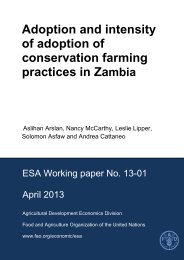Adoption and intensity of adoption of conservation farming practices in Zambia
Adoption and intensity of adoption of conservation farming practices in Zambia
Adoption and intensity of adoption of conservation farming practices in Zambia
Create successful ePaper yourself
Turn your PDF publications into a flip-book with our unique Google optimized e-Paper software.
Exist<strong>in</strong>g empirical analyses <strong>of</strong> CF <strong>in</strong> <strong>Zambia</strong> (Haggblade <strong>and</strong> Tembo 2003; Chomba 2004;<br />
Baudron et al. 2007; Tembo et al. 2007; Haggblade, Kabwe, <strong>and</strong> Plerhoples 2011; Nyanga<br />
2012) are mostly subject to small sample sizes, cross sectional surveys, or <strong>in</strong>adequate detail<br />
<strong>in</strong> data, which prevents them from effectively captur<strong>in</strong>g the multiple factors that affect<br />
farmers’ decisions to adopt CF. Although it is sometimes acknowledged that most <strong>adoption</strong> is<br />
partial or <strong>in</strong>cremental, <strong>adoption</strong> <strong>in</strong> this literature is usually def<strong>in</strong>ed as hav<strong>in</strong>g any area under<br />
one or more CF practice due to lack <strong>of</strong> detail <strong>in</strong> data.<br />
This paper addresses these shortcom<strong>in</strong>gs by us<strong>in</strong>g data from the Rural Incomes <strong>and</strong><br />
Livelihoods Surveys that were implemented <strong>in</strong> 2004 <strong>and</strong> 2008. 2 More than 5,000 <strong>and</strong> 8,000<br />
households were <strong>in</strong>terviewed <strong>in</strong> 2004 <strong>and</strong> 2008, respectively. We merge the rich household<br />
panel data with historical Ra<strong>in</strong>fall Estimate data (RFE) at the district level to analyse the<br />
determ<strong>in</strong>ants <strong>and</strong> the <strong><strong>in</strong>tensity</strong> <strong>of</strong> <strong>adoption</strong> <strong>of</strong> one <strong>of</strong> the important pillars <strong>of</strong> CF:<br />
zero/m<strong>in</strong>imum tillage (plant<strong>in</strong>g bas<strong>in</strong>s).The Rural Incomes <strong>and</strong> Livelihoods Surveys (RILS)<br />
data provide us with the possibility to employ panel data econometric techniques to control<br />
for time-<strong>in</strong>variant household, community, <strong>and</strong> <strong>in</strong>stitutional characteristics that may affect<br />
farmers’ decisions <strong>and</strong> confound the results <strong>of</strong> cross-sectional analyses dom<strong>in</strong>ant <strong>in</strong> the<br />
literature.<br />
2. BACKGROUND<br />
2.1. History <strong>of</strong> CA <strong>in</strong> the World <strong>and</strong> <strong>in</strong> <strong>Zambia</strong><br />
Historically, CA was born out <strong>of</strong> ecological <strong>and</strong> economic hardships <strong>in</strong> the United States<br />
(U.S.) caused by catastrophic droughts dur<strong>in</strong>g the 1930s <strong>and</strong> became more popular among<br />
farmers due to ris<strong>in</strong>g fuel prices dur<strong>in</strong>g the 1970’s (Haggblade <strong>and</strong> Tembo 2003). Large<br />
commercial farmers took up m<strong>in</strong>imum tillage technologies to combat the drought-<strong>in</strong>duced<br />
soil erosion <strong>and</strong> save on fuel costs. Around 35% <strong>of</strong> total area <strong>in</strong> the U.S. was cultivated us<strong>in</strong>g<br />
m<strong>in</strong>imum tillage technologies dur<strong>in</strong>g 1980’s (Haggblade <strong>and</strong> Tembo 2003). The CA<br />
experience <strong>in</strong> the U.S. gave impetus to the CA movement <strong>in</strong> South America (ma<strong>in</strong>ly Brazil)<br />
<strong>and</strong> Southern Africa (ma<strong>in</strong>ly South Africa <strong>and</strong> Zimbabwe), where government agricultural<br />
research centers established <strong>conservation</strong> tillage programs to actively promote CA<br />
(Haggblade <strong>and</strong> Tembo 2003).<br />
CA as promoted <strong>in</strong> <strong>Zambia</strong> is called CF <strong>and</strong> consists <strong>of</strong> a package <strong>of</strong> follow<strong>in</strong>g <strong>practices</strong>: (1)<br />
reduced tillage on no more than 15% <strong>of</strong> the field area without soil <strong>in</strong>version, (2) precise<br />
digg<strong>in</strong>g <strong>of</strong> permanent plant<strong>in</strong>g bas<strong>in</strong>s or ripp<strong>in</strong>g <strong>of</strong> soil with a Magoye ripper (the latter<br />
where draft animals are available), (3) leav<strong>in</strong>g <strong>of</strong> crop residues on the field (no burn<strong>in</strong>g), (4)<br />
rotation <strong>of</strong> cereals with legumes <strong>and</strong> (5) dry season l<strong>and</strong> preparation (CFU 2007). 3 The<br />
emergence <strong>of</strong> CF <strong>in</strong> <strong>Zambia</strong> <strong>in</strong> 1990’s also accompanied ecological <strong>and</strong> economic challenges.<br />
With the abrupt end<strong>in</strong>g <strong>of</strong> subsidies for maize, fertilizer <strong>and</strong> farm mach<strong>in</strong>ery follow<strong>in</strong>g the<br />
collapse <strong>of</strong> copper prices, <strong>Zambia</strong>n farmers found themselves try<strong>in</strong>g to cultivate heavily<br />
degraded soils without the extra <strong>in</strong>puts they had been us<strong>in</strong>g for three decades. The<br />
experiences <strong>of</strong> farmers with CA <strong>in</strong> the U.S. <strong>and</strong> Zimbabwe helped commercial maize farmers<br />
<strong>in</strong> <strong>Zambia</strong> to become <strong>in</strong>terested <strong>in</strong> CA. Though the ma<strong>in</strong> motivation was to save on fuel costs,<br />
other benefits such as improved soil structure <strong>and</strong> productivity were also appreciated, hence<br />
2<br />
We thank the Indaba Agricultural Policy Research Institute (IAPRI) <strong>and</strong> the <strong>Zambia</strong> Food Security Research<br />
Project (FSRP) for provid<strong>in</strong>g the data.<br />
3<br />
Throughout the paper, we use the term CA when referr<strong>in</strong>g to the general literature, but CF for the case <strong>in</strong><br />
<strong>Zambia</strong>.<br />
2



